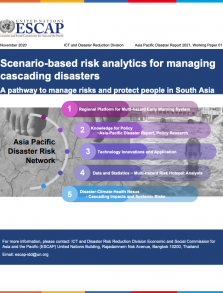
The COVID-19 pandemic has made it clear that biological and natural hazards intersect with each other and increase the complexity of overall disaster impacts on populations and economies. But disaster management and risk analytics have been slow to capture the intersections of natural and biological hazards or capture the dimensions of interconnectedness and cascading effects to the social, economic, and environmental ecosystems. These challenging times call for a reformulation and paradigm shift from a single hazard, single sector perspective to a multi-hazard, multi-sectoral and systemic risk perspective. To achieve this, building multiple and complex risk scenarios that take the converging biological and natural hazard risks will be a priority. This study is a step in this direction. Through the integration of data from multiple sources, this study extends the riskscape of the region and examines the cascading risks that are arising and will arise in the future from the impacts of natural and biological hazards. Specifically, the study provides a methodology for building an integrated scenario assessment for strategic management and policy development in South Asia.


